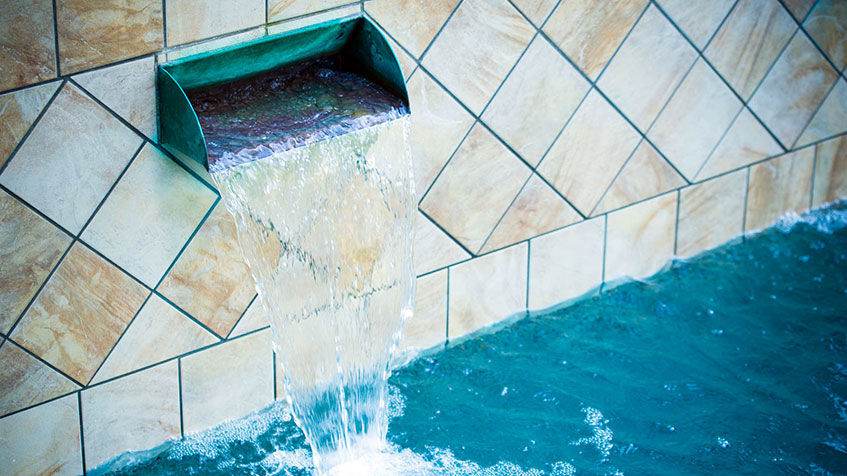Identifying the wrong stain type can cost you hundreds in wasted cleaning products and potentially damage your tiles permanently. After 35+ years of treating Sacramento pool tiles, I’ve seen homeowners turn manageable calcium buildup into expensive restoration projects simply because they used the wrong approach based on misidentifying their stain type.
Just last month, I visited a family in Elk Grove who had been battling "rust stains" for three months with iron removal products. The tiles were getting worse, not better. Five minutes of professional assessment revealed copper staining from equipment corrosion, not iron contamination. Wrong diagnosis, wrong treatment, escalating damage. The right approach cleared the stains in two hours.
Sacramento’s unique water and climate conditions create distinctive staining patterns that require specific identification skills and targeted treatment approaches. Understanding these differences isn’t just about getting better cleaning results—it’s about preventing expensive mistakes that can damage tiles beyond repair.
Here’s what you need to know about identifying and treating the stain types that plague Sacramento pools.
Calcium Buildup: Sacramento’s Relentless Challenge
Calcium buildup represents the most common and persistent tile problem facing Sacramento pool owners. These white, chalky, crusty deposits form when dissolved calcium in our hard water precipitates out of solution due to evaporation, high pH levels, or chemical imbalances.
Why Calcium Is Virtually Inevitable Here
Sacramento’s municipal water supply contains 200-400 parts per million of calcium hardness—well into the range that creates scaling problems. To put this in perspective, water below 150 ppm is considered moderately hard, while our levels consistently exceed what’s considered very hard.
The formation process begins innocently. Normal evaporation concentrates dissolved minerals until they reach saturation levels and begin precipitating onto pool surfaces. These initial deposits provide nucleation sites for additional accumulation, creating the thick, rough buildup that characterizes severe calcium scaling.
Joe’s Pro Tip: I tell customers that calcium buildup in Sacramento isn’t a question of "if" but "when" and "how much." The key is recognizing it early when removal is still simple and affordable rather than waiting until it becomes a restoration project.
pH elevation accelerates the process. Sacramento water naturally tends toward alkaline conditions, which speeds calcium precipitation. Every time pH rises above 7.6, you’re creating conditions that push calcium out of solution onto your tiles.
Identifying Calcium Buildup Stages
Light buildup appears as a thin white film or powder that can be scratched off with a fingernail. This is when intervention is most effective and least expensive—often just requiring proper chemical balance and regular brushing.
Moderate scaling shows as noticeable white, chalky deposits along waterlines that feel rough to the touch. At this stage, you need professional assessment to determine the best removal approach without tile damage.
Severe accumulation creates thick, crusty formations that can extend several inches above waterlines. These deposits become so hard they resist normal cleaning and may require aggressive removal techniques.
Texture changes accompany all stages, with smooth tiles developing rough, gritty surfaces that harbor bacteria and become uncomfortable for swimmers.
The Two Types That Require Different Approaches
Calcium carbonate scaling appears as white, chalky deposits with relatively soft texture. These form under normal pH conditions and respond well to mild acid treatment. Most Sacramento pools develop this type initially.
Calcium silicate scaling appears grayish with harder, glassy texture. These form under very high pH conditions and elevated temperatures, resisting standard acid treatment. This type requires aggressive mechanical removal or media blasting that only professionals should attempt.
What this means for you: trying to treat calcium silicate with acid-based products wastes time and money while potentially etching your tiles. Professional identification ensures you use the right approach from the start.
Organic Stains: Sacramento’s Natural Contamination
Organic stains result from natural materials including leaves, algae, dirt, dead insects, suntan lotion, and other organic debris. Sacramento’s outdoor environment creates year-round sources of organic contamination that require understanding for effective management.
Sacramento’s Organic Stain Sources
Valley oaks and landscaping produce abundant debris throughout the year. Our large mature trees drop leaves, pollen, sap, and bark that create persistent staining without proper management.
Wind patterns transport organic debris from surrounding areas, depositing material that wouldn’t naturally occur in your immediate pool area. This makes organic contamination an ongoing challenge rather than a seasonal issue.
Outdoor lifestyle means increased pool usage that adds body oils, sunscreen, food spills, and other organic contamination. The more you enjoy your pool, the more organic staining potential develops.
Identifying Organic Stain Types
Green staining comes from algae growth or chlorophyll from leaves and plant matter. It appears as bright to dark green discoloration that may feel slimy or film-like. Treatment involves chlorine shock, enzyme cleaners, and aggressive brushing.
Brown/black staining results from decomposing organic matter and tannins from leaves. These appear as brown to black patches or streaks that are usually flat discoloration rather than raised deposits. Treatment requires enzyme cleaners and organic stain removers.
Reddish staining comes from tannins and certain organic compounds, appearing as red to rust-colored discoloration often concentrated around debris accumulation areas. This can be confused with iron staining, making professional identification valuable.
I had a customer in Fair Oaks who spent $300 on iron removal products for reddish stains that were actually tannin staining from oak leaves. The right organic stain remover cleared the problem for $30. Professional identification prevents expensive misdiagnosis.
Metal Stains: Equipment and Water Source Issues
Metal staining creates distinctive coloration patterns that help identify sources and guide treatment, but misidentification leads to ineffective treatment and potential tile damage.
The Big Three Metal Stain Types
Blue-green copper stains come from pool equipment corrosion or copper-based algaecides. These appear as bright blue to blue-green discoloration, usually forming under low pH conditions. Treatment involves ascorbic acid, chelating agents, and pH adjustment.
Brown/red iron stains result from rust in equipment or iron in water supplies. These appear as brown to reddish-brown discoloration, often forming during pH fluctuations. Treatment requires ascorbic acid and source elimination.
Black manganese stains come from certain water supplies or equipment degradation. These appear as dark brown to black discoloration, forming under high pH and oxidizing conditions. Treatment requires specialized removal agents and system adjustment.
Formation Conditions Matter
Low pH levels increase metal solubility, then sudden changes cause precipitation onto surfaces. This is why metal staining often appears after major chemical adjustments or equipment problems.
High sanitizer levels create oxidizing conditions that precipitate metals onto tile surfaces. Over-chlorination can actually cause metal staining rather than preventing it.
Equipment corrosion introduces metals into pool water that precipitate under certain chemical conditions. Identifying whether staining comes from water sources or equipment problems affects both treatment and prevention strategies.
What this means for you: treating the stain without addressing the source leads to recurring problems. Professional analysis identifies both the metal type and its source for comprehensive solutions.
Oil and Grease Stains: The Invisible Problem
Normal pool use inevitably introduces oils and greases from sunscreen, body oils, and food spills. These don’t just affect appearance—they make tiles slippery and unsafe while harboring bacteria.
Identifying Oil Contamination
Visual signs include rainbow sheens on water surfaces, greasy bands along waterlines, loss of shine on previously glossy tiles, and slippery feel on tile surfaces.
Contamination sources include sunscreen and lotions, natural body oils, food spills from poolside activities, and environmental contamination from airborne oils.
Treatment requirements involve specialized enzyme cleaners and degreasing agents that break down oil molecules without damaging tiles. Regular cleaning products often just spread oil contamination rather than removing it.
Sacramento’s Seasonal Stain Patterns
Local conditions create unique staining patterns that reflect our specific water quality, climate, and environmental factors. Understanding these helps anticipate and prevent problems.
Summer Challenges
Intensive calcium buildup from peak evaporation concentrating minerals creates the year’s most severe scaling problems. Organic contamination increases from heavy pool usage and outdoor activities. Oil accumulation peaks from sunscreen use and entertaining.
Winter Issues
Diluted chemistry from rainfall affects chemical balance and can trigger metal precipitation. Metal contamination from rainwater introduces trace metals that create staining. Organic debris from winter storms concentrates in pool areas.
Spring/Fall Transitions
Mixed contamination from changing conditions creates combination staining requiring multiple treatment approaches. Organic debris peaks from maximum tree material contribution create the year’s worst organic staining challenges.
I learned to adapt maintenance programs for these seasonal patterns through decades of Sacramento experience. Anticipating seasonal challenges prevents problems rather than just reacting to them.
Professional Identification Prevents Expensive Mistakes
Pool Time’s comprehensive stain identification process ensures accurate diagnosis through expert analysis that considers local water conditions, climate factors, and environmental influences.
Why Professional Assessment Matters
Visual assessment by experienced professionals distinguishes between similar-appearing stain types that require different treatments. Source identification determines contamination origins for targeted treatment that addresses root causes.
Treatment planning selects optimal approaches for specific stain types, preventing the expensive trial-and-error that damages tiles and wastes money.
Prevention strategies address underlying causes to prevent recurrence rather than just treating symptoms repeatedly.
One customer noted about our seasonal expertise: "I have a very challenging pool and water feature to care for due to many trees and the service is amazing. Generally the service is once a month but in the fall they service twice a week." – Nikke Sosnick (Google)
When to Seek Professional Help
Multiple stain types present simultaneously require expert analysis to identify all contributing factors for comprehensive treatment planning.
Previous treatment failures suggest misidentification that professional analysis can correct before additional damage occurs.
Expensive tile materials like natural stone justify professional assessment to prevent damage from inappropriate cleaning attempts.
Uncertain stain sources benefit from expert identification that ensures effective treatment from the start rather than expensive experimentation.
Protecting Your Tile Investment
Accurate stain identification represents the foundation of effective tile care that protects your investment while maintaining beauty and functionality.
Professional stain identification advantages include: understanding that Sacramento’s challenging conditions make professional expertise particularly valuable because local water and climate factors create unique problems requiring specific knowledge and experience, implementing early intervention based on correct identification that prevents manageable problems from becoming expensive restoration projects, and providing comprehensive treatment that addresses both current staining and underlying causes for lasting results rather than temporary improvements.
Sacramento’s challenging conditions make professional expertise particularly valuable because local water and climate factors create unique problems requiring specific knowledge and experience.
Early intervention based on correct identification prevents manageable problems from becoming expensive restoration projects that could have been avoided.
Comprehensive treatment addresses both current staining and underlying causes to provide lasting results rather than temporary improvements that fail quickly.
With over 3 decades of experience as a pool contractor, I’ve learned that accurate stain identification is often more important than the cleaning technique itself. Get the diagnosis right, and treatment becomes straightforward. Get it wrong, and you can turn a simple problem into an expensive disaster.
If you’re dealing with tile stains and want accurate identification that guides effective treatment, give me a call at 916-638-7665. I’m always happy to chat about what might work best for your specific situation—no pressure, just straight answers from someone who’s seen it all.
Visit our weekly pool service page to learn about comprehensive maintenance programs that prevent staining through proper water chemistry management, or explore our pool spa services for specialized stain identification and targeted treatment solutions, or check out our finish and tile services for professional tile restoration when staining is beyond basic cleaning.
Pool Time Pool & Spa has been Sacramento’s trusted stain identification specialist for over 35 years. As a locally owned business that’s fully licensed, bonded, and insured, we provide expert analysis and targeted treatment solutions designed specifically for our challenging local conditions.


